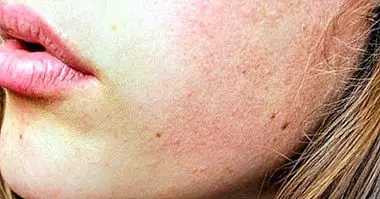Fungi in the mouth: symptoms, causes and treatment
Talk, sing, eat, laugh, kiss ... our mouth is one of the most versatile and useful parts of our body, which we use in many different ways in order to adapt to the environment. It is a highly innervated body area on which we have a great capacity for control.
And yet, it is also a very delicate part of our organism that is often in contact with bacteria and elements coming from both the interior (as well as the intestinal flora) and from the outside. Sometimes it is possible that we get to suffer some kind of infection or problem, being one of the possible causes the appearance of fungi in the mouth .
Throughout this article we will observe which are the main symptoms that warn us of the presence of a possible oral fungal infection, some of its possible causes and how they can be treated.
- Related article: "How to cure sores and canker sores in the mouth in 8 steps
Mushrooms in the mouth: what are they?
We are talking about fungal infections or mycoses when we are referring to the existence of a series of symptoms derived from the presence of different species of fungi in our body. These infections can occur in any part of the body, such as the skin or the genital tract, and in the case that concerns us in this article also in one of the most exposed body openings and in contact with external elements or with microbes dedicated to processing food: the mouth.
There are many fungi that can reach our body, and many of them have the capacity to cause infections. Some of the best known and most common orally are fungi Candida albicans and the Candida tropicalis, which can cause oral candidiasis. Other examples are Paracoccidioides brasiliensis (existing in Latin America and that penetrates the body by inhaling its spores in respiration) or Cryptococcus neoformans.
symptom
Fungal infection in the mouth is usually asymptomatic at first , that is to say that at the beginning the affected person may not perceive any type of alteration or discomfort. However, as these fungi grow and multiply they can cause different discomforts and injuries.
Between these injuries and alterations the presence of inflammation and / or bleeding in the gums and / or tongue, mouth or throat pain are frequent , appearance of white plaques (which are removed with scraping and leave behind bleeding lesions) or reddish or bleeding lesions, cracks and canker sores on the tongue or lips, and bad breath. In general, they are not usually dangerous, but some caution must be taken because in some cases they can generate serious complications and infections and inflammations in different organs.
How do they get there? Risk factors for its appearance
The appearance of fungi at the oral level does not have a single and clear cause, but it can be given and be influenced by a wide variety of factors. In general, if this is possible, it is because there are sufficient conditions in the mouth of the subject for fungi to grow. It it does not have to imply a lack of hygiene , but they can also be different diseases or even our lifestyle and food which facilitates the existence of the necessary elements for the survival of the fungus.
There are many factors that facilitate infection. Among them we can find the presence of diabetes (in which there is also higher concentration of sugars in saliva, something that serves as food) or anemia, in addition to congenital or acquired immunodeficiency (since the lack of nutrients such as vitamins and / or the defenses of the immune system facilitates the survival of the fungus).
Also, also excess intake or excessive consumption of certain foods It favors the birth and reproduction of fungi. Disorders or endocrine and hormonal alterations can also be factors that influence their appearance or maintenance. Finally, the consumption of substances, whether adulterated or not, greatly helps their appearance, especially in the case of tobacco or alcohol.
The lack of dental hygiene or the existence of prostheses or areas of difficult access when cleaning the mouth also generates an increase in the probability of suffering from them. Some diseases such as leukemia or other infections can also favor them, due to the existence of a lower response of the immune system.
Also, some drugs can lead to buccal mycosis , as some antibiotics or corticosteroids (among which are some vaporized or by aspiration). The treatment of chemotherapy and radiotherapy also, by decreasing the defenses.
In addition to this, we must bear in mind that there are vital periods of greater vulnerability, among which the first moments after birth, early childhood, old age or pregnancy stand out. In general, the changes generated at the hormonal level or the lowering of defenses or substances capable of fighting or stopping the fungus are considerable risk factors.
- Maybe you're interested: "The 11 types of mushrooms (and their characteristics)"
Treatment
Treating the presence of fungi in the mouth will require a specific approach depending on the fungus and the presence of other factors such as possible comorbid diseases. However, at a general level they can be used antifungal or antifungal medications , which can act by slowing their growth or directly killing them.
Some of these drugs can be nystatin (of the most used, especially in oral candidiasis) or ciclopiroxolamina. Systemic treatments such as ketoconazole can also be applied (although the latter depending on the amounts can be hepatotoxic). Now, you have to keep in mind that these drugs must be prescribed by a doctor and that some can not be taken for example by pregnant women or people with certain basic health problems.
It is also necessary to take into account the need for prevention or to add to the diet foods that favor the control of oral pH, such as yogurt, or allow to acquire vitamins, fibers and nutrients that help keep the body well balanced. The brushing and correct dental hygiene is also of great help. In cases where there are diseases such as those mentioned, it will also be necessary to take into account that it is necessary to treat them with the corresponding methods.
Bibliographic references:
- Caballero Martínez, F .; Jurado Moreno, J. and López Rocha, A. (2005). Guide of good clinical practice in fungal infections. Medical Association of Spain. Ministry of Health. Spain.
- Pardi, G.H .; Mata, S .; Colella, M.T., Roselló, A. and Pineda, V. (2013). Mycosis of the oral cavity - Part I. Bibliographic Reviews. Venezuelan Odontological Act, 51 (2).



















